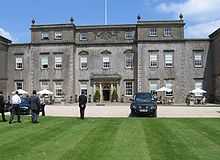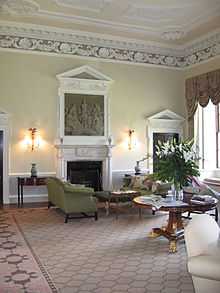Ston Easton Park

Ston Easton Park in Somerset was built in the 18th century for John Hippisley Coxe. The Hippisley family had been Lords of the Manor of Ston Easton since 1544, and in the 17th century had moved from the old manor house by the parish church to a new Jacobean house. This Jacobean house was converted into a Palladian mansion by John Hippisley Coxe.


The identity of the architect is not known, and although the design is reminiscent of the work of William Kent modern research tends to suggest Thomas Paty was the architect.[2] It is also not known exactly when the house was built. John Hippisley Coxe died in 1769 and his sons Richard and Henry further embellished the house and grounds. Henry Hippisley Coxe employed Humphry Repton to design a landscape park, although only part of this plan was actually created. Henry's widow Elizabeth further developed the grounds in about 1814.
In 1956 Richard John Bayntun Hippisley died, and his son John Preston Hippisley was obliged to sell Ston Easton in order to pay death duties. The house was neglected and fell into disrepair — it was even proposed that the building should be demolished, though it was saved by a Preservation Order in 1958. In 1964 Ston Easton was purchased by William Rees-Mogg who restored the building.[3] In 1978 Rees-Mogg sold the house to the Smedley family, who further restored the house and grounds and subsequently converted it into a hotel. The house was sold again in 2001 to Von Essen Hotels,
Ston Easton has gardens and landscaped grounds of around 3 hectares (7 acres) and the remains of a park of some 60 hectares (150 acres).[4]
Further reading
- Jones, Ivan Fitzroy Hippisley & Hippisley, Alfred Edward, (eds.), Some Notes on the Hippisley Family, Wessex Press, 1952
External links
- Papers of the Hippisley Family of Ston Easton, Somerset Heritage Centre, Taunton, Reference: DD/HI
- Ston Easton Park Official Website
- Matthews, Mike, A Brief History of the Hippisley Family, www.boddyparts.co.uk, 2000-2014
Coordinates: 51°17′6″N 2°32′37″W / 51.28500°N 2.54361°W
References
- ↑ Burke's Genealogical and Heraldic History of the Landed Gentry, 15th Edition, ed. Pirie-Gordon, H., London, 1937, p.1120
- ↑ Priest, Gordon (2003). The Paty Family: Makers of Eighteenth-Century Bristol. Redcliffe Press.
- ↑ Reid, Robert Douglas (1979). Some buildings of Mendip. The Mendip Society. ISBN 0-905459-16-4.
- ↑ "Ston Easton Park". Parks and Gardens UK. Retrieved 9 June 2013.